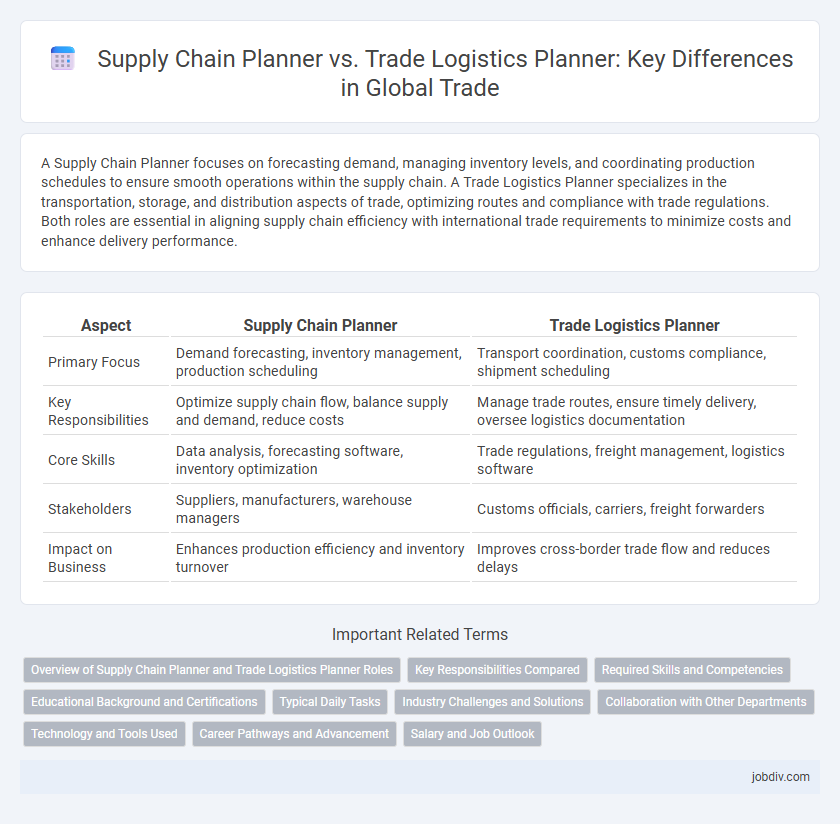A Supply Chain Planner focuses on forecasting demand, managing inventory levels, and coordinating production schedules to ensure smooth operations within the supply chain. A Trade Logistics Planner specializes in the transportation, storage, and distribution aspects of trade, optimizing routes and compliance with trade regulations. Both roles are essential in aligning supply chain efficiency with international trade requirements to minimize costs and enhance delivery performance.
Table of Comparison
| Aspect | Supply Chain Planner | Trade Logistics Planner |
|---|---|---|
| Primary Focus | Demand forecasting, inventory management, production scheduling | Transport coordination, customs compliance, shipment scheduling |
| Key Responsibilities | Optimize supply chain flow, balance supply and demand, reduce costs | Manage trade routes, ensure timely delivery, oversee logistics documentation |
| Core Skills | Data analysis, forecasting software, inventory optimization | Trade regulations, freight management, logistics software |
| Stakeholders | Suppliers, manufacturers, warehouse managers | Customs officials, carriers, freight forwarders |
| Impact on Business | Enhances production efficiency and inventory turnover | Improves cross-border trade flow and reduces delays |
Overview of Supply Chain Planner and Trade Logistics Planner Roles
Supply Chain Planners coordinate demand forecasting, production scheduling, and inventory management to optimize the end-to-end supply chain process. Trade Logistics Planners focus on managing the transportation, customs compliance, and distribution of goods across international borders. Both roles require expertise in data analysis and cross-functional collaboration to ensure efficient product flow and meet market demands.
Key Responsibilities Compared
Supply Chain Planners focus on demand forecasting, inventory management, and production scheduling to ensure materials and products are available efficiently. Trade Logistics Planners specialize in coordinating transportation, customs compliance, and distribution strategies to optimize cross-border trade processes. Both roles collaborate to align supply chain activities with trade regulations and delivery timelines.
Required Skills and Competencies
Supply Chain Planners require expertise in demand forecasting, inventory optimization, and production scheduling to ensure efficient resource allocation and timely product availability. Trade Logistics Planners focus on skills in customs regulations, international shipping coordination, and trade compliance to manage cross-border transportation and distribution effectively. Both roles demand strong analytical abilities, proficiency in supply chain management software, and exceptional communication skills for collaboration across global teams.
Educational Background and Certifications
Supply Chain Planners typically possess a degree in supply chain management, logistics, or industrial engineering, often complemented by certifications such as APICS CPIM or CSCP. Trade Logistics Planners usually have educational backgrounds in international trade, business administration, or logistics, with certifications like CILT, IATA, or customs brokerage credentials enhancing their expertise. Both roles benefit from continuous professional development focused on global trade compliance, inventory management, and transportation strategies.
Typical Daily Tasks
A Supply Chain Planner typically manages inventory levels, forecasts demand, and coordinates procurement schedules to ensure materials are available for production. In contrast, a Trade Logistics Planner focuses on organizing transportation, customs documentation, and compliance with international trade regulations to facilitate timely delivery. Both roles require close collaboration to optimize supply chain efficiency and minimize costs.
Industry Challenges and Solutions
Supply Chain Planners face challenges like demand volatility and inventory optimization, requiring advanced forecasting tools and integrated supply chain management systems to enhance efficiency. Trade Logistics Planners confront complexities in cross-border regulations, customs compliance, and transportation coordination, leveraging technology-driven visibility platforms and strategic partnerships to streamline international trade operations. Both roles demand adaptive strategies and real-time data analytics to mitigate risks and ensure seamless movement of goods in global markets.
Collaboration with Other Departments
Supply Chain Planners collaborate closely with procurement, manufacturing, and sales teams to align inventory levels and production schedules with demand forecasts, enabling efficient resource allocation. Trade Logistics Planners work in tandem with customs, shipping, and compliance departments to ensure seamless international freight movement and adherence to trade regulations. Both roles require strong interdepartmental communication to optimize end-to-end supply chain performance and minimize operational disruptions.
Technology and Tools Used
Supply Chain Planners leverage advanced forecasting software, ERP systems like SAP and Oracle, and optimization algorithms to enhance demand planning, inventory management, and production scheduling. Trade Logistics Planners utilize transportation management systems (TMS), global trade management (GTM) platforms, and real-time tracking tools to streamline import/export operations, customs compliance, and shipment coordination. Both roles integrate data analytics and automation technologies to improve operational efficiency and reduce supply chain costs.
Career Pathways and Advancement
Supply Chain Planners focus on forecasting demand, managing inventory levels, and coordinating production schedules, offering career advancement into roles such as Demand Planning Manager or Supply Chain Director. Trade Logistics Planners specialize in optimizing transportation routes, managing customs compliance, and coordinating cross-border shipments, with potential growth into positions like Logistics Manager or International Trade Compliance Officer. Both career pathways emphasize analytical skills and strategic planning, but differ in their specialization within trade operations and supply chain management.
Salary and Job Outlook
Supply Chain Planners typically earn an average salary ranging from $65,000 to $85,000 annually, with steady job growth driven by increasing global trade complexities. Trade Logistics Planners often command higher salaries, averaging $75,000 to $95,000, due to specialized expertise in international shipping and customs compliance. Both roles show positive job outlooks, but Trade Logistics Planners benefit from rising demand in global logistics and trade facilitation sectors.
Supply Chain Planner vs Trade Logistics Planner Infographic

 jobdiv.com
jobdiv.com